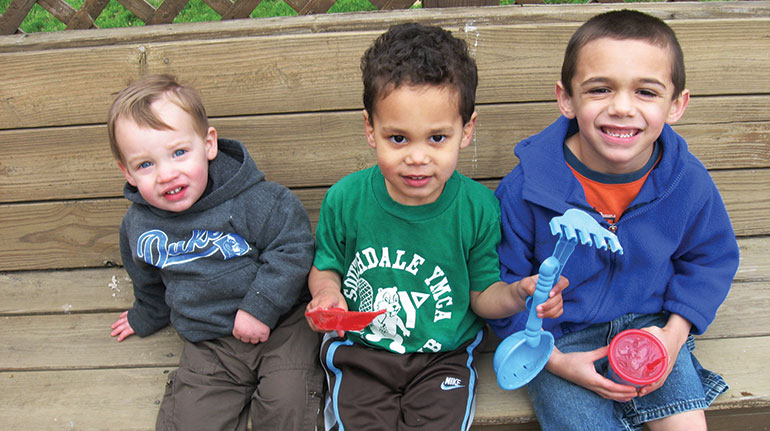When we decided to adopt for a second time, we were worried about how our older (and slightly diva-ish) daughter would take to sharing the spotlight. As it turned out, we didn’t need to worry—after spending the year-and-a-half leading up to their meeting talking about and dreaming about her little sister, it was about an hour into big sisterhood when Katie declared herself Maggie’s best friend. And, except for a few scuffles over fairy wings and tutus, my girls have been tight ever since.
I know how lucky we are—the path to serene siblinghood is not always so smooth. But there are techniques you can use to help your child accept—and maybe even adore—your new addition. Here’s advice from the best experts: adoptive parents who have successfully navigated this tricky terrain.
Find the Right Time to Break the News
Deciding when to spill the beans is tricky—many adoption journeys involve vague time frames. Here’s how to make the determination.
The younger the child, the less notice you need to give him. With younger children, for whom tomorrow seems like forever away, it may make sense to wait until you’ve been matched with their future sibling—or even until you’re ready to bring the new child home. “Time, to children, is today or not today,” says Joni Mantell, LCSW, director of the Infertility and Adoption Counseling Center, in New Jersey and New York. “Wait until you are close to the adoption and more certain. Too much buildup time can produce anxiety in children.”
Older children—those in elementary school and beyond—should probably be told as soon as you know. “My husband and I told our children that we were going to adopt after we had the paperwork done and were ready for the homestudy,” says mom Kathryn, in California. “We had conversations about how our family would change by adopting two older children, and how we would handle those changes. We listened to their concerns and assured them that all would be well.”
Factor in your child’s (and your own) patience level. A lot depends on your child’s ability to manage the wait—and on your tolerance for all of those “when” questions. “After we started the process to adopt, the wait was 10 to 12 months,” says Noriko Lovasz. “We decided to make the conversations casual, and we discussed it often. As the wait went on, we wondered how our daughter would handle the uncertainty. She asked us from time to time when we were traveling to China to get ‘her baby,’ and we were honest, telling her that we weren’t sure. But we always ended the question-and-answer sessions on an upbeat note, saying that we couldn’t wait to go to China to get her little brother or sister.”
Explain a potential placement clearly. In domestic adoption, don’t tell your child that he’s getting a little brother or sister until the placement is deemed final. Experts recommend explaining it with something like, “We’re going to be taking care of this baby while his birth mother decides whether she can parent him. If she decides that adoption is better, we will get to be his forever family.”
Help Your Child Understand the Process
Even if your child was adopted and has heard his adoption story before, odds are, there are differences you’ll want to share.
Play show and tell. Let your child see the paperwork you’ve had to fill out and the steps you’ve taken. “After we completed a scrapbook to show potential birth families, we showed our son the scrapbook that his own birth mother had looked at, and talked about his adoption process,” says Marnie Shiels, a mom in Virginia. “Then we showed him the new scrapbook and talked about what to expect.”
Compare and contrast the journeys to your family. This is a perfect opportunity to talk about the different ways people come into families—and to compare your new child’s path to your family with his path. Be especially careful if you’re explaining adoption to a biological child. “Children can find the idea that parents place a baby for adoption confusing, if not terrifying,” Mantell advises. “In your child’s experience, this is not what mommies and daddies do. Assure your child that adoptions occur because of parents’ circumstances and not because something is wrong with the baby; and that the circumstances of your family are that this would never happen to him or to the new baby.”
Find Fun Ways to Teach Them About Siblings
Your conversations are important, but there are other ways to pave the way to good sibling relations.
Introduce a few books about siblings to your shelf. Check out “Big-Sib Books” for suggestions, and add them to your regular story rotation.
Watch for sibling relationships within movies and shows you like. They make excellent starters for conversations with your kids.
Look for families like yours to hang out with. “We spent time with family and friends who had also adopted internationally,” says Stephanie Deere. “They were proof that other families adopt, too, have children from different countries, and that our adoption would eventually be completed.”
Introduce some elements from your child-to-be’s culture into your daily lives. If you’re adopting from another culture, this gives you and your child an opportunity to better understand your new child’s origins. “We taught our children a few Kreyol words and phrases, and we use them in our daily lives,” says Cheryl Bissaillon, who is waiting to complete the adoption of a girl from Haiti. “Our children know that their new sister will not understand everything we say, and we won’t understand her at first.”
Include your Child in the Preparations
Find ways for your child to help you get ready for your new addition, to help her feel more invested in her future sibling.
Let her help you pick out baby gear. “Try to involve your child in the preparation in a way that is age-appropriate,” Mantell suggests. “She can choose things you need for the baby—the color of the stroller, for example.”
Give him a creative outlet. “We involved our three-year-old son in every part of the process,” says Angela Cline. “We took him shopping, to buy his new baby brother gifts to be sent to Korea, and he was 100-percent involved in the room-decorating process—he wore goggles and painted right alongside us. He was an important part of the process, and we made sure that he knew that.”
Put him in charge. Give him some aspects to control—new tasks to take on. “Put him in charge of picking out clothes or getting diapers,” suggests JoAnne Solchany, Ph.D., ARNP, an infant mental health specialist, in Seattle, and an adoptive mom. Just be sure not to go overboard. “One major mistake I see is giving a child too many caregiving chores and telling him ‘this is your baby.’ It is not his baby, it is his sibling.”
Make Big Changes Far Ahead
You don’t want to have your child equate stress-inducing changes with the introduction of her new sibling, so make adjustments long before your new child comes home.
Make the big change a big deal (in a good way). “We made a huge fuss over her getting a big-girl bed and a new room well before we had concrete travel plans,” says mom Noriko. “She wasn’t put-out by the new baby’s arrival. We let her pick out her new dresser, and we decorated her big-girl room in her favorite princess theme.”
Prepare your child for small changes, as well. “I was always telling my daughter to ‘hold on a moment’ when the new baby came, and she wasn’t used to that, because I had waited on her hand and foot,” says Angie Connolly. Let your child know that new babies need a lot of love and attention, and that he needs to be patient while you care for the baby—but you will always have special time for him, too. Encourage the older sibling to be your helper as you care for the baby.
Think about the best way to handle the children’s first meeting. Some families leave their children with relatives while they travel to adopt, so they can focus on bonding without the complication of siblings. But many been-there, done-that parents regret that decision. “We decided that it would be better for only one of us to travel the second time,” says Jane Blannin-Bruleigh, mom to two children adopted from China. “That was the biggest mistake we made. The sibling competition for attention would have been easier to adapt to there, because there was nothing to do except be a family.”
Prepare for a Tough Transition
All your preparation may not make a reluctant sibling excited about another child joining her family. These ideas may make the transition smoother.
Help your child see her new sibling in a positive light. Give your child a small gift from her new sibling, and look for ways to encourage their relationship. “Talk for the baby,” suggests Solchany. Try saying things like, “Oh, look at him looking at you, he is telling me he is lucky to have a big brother like you.”
Celebrate your child’s transition to big siblinghood. “We had a special ‘big sister’ wishing well at the baby shower,” says Kim Connell, who adopted her younger child from Ethiopia. “Everyone brought things that she could use on our trip—puzzle books, crafts, and card games.”
Give your child time to discuss his ambivalence about the new sibling. Even the most doting big brother or sister may be annoyed at times about the changes the new child has brought. “Let your child vent about his new sibling wrecking his toys for example, or making Mommy too busy,” Mantell says. “These feelings are part of adjusting to a new sibling, rather than a mean or selfish streak. You want to give your first child the message that his feelings count.”
Let your child keep some things to himself. “Validate his feeling that sharing is difficult, and make some things ‘just his’ that he doesn’t have to share with the new sibling,” Mantell suggests.
Plan some special, just-the-two-of-us activities for you and your child. Give him one-on-one time after the new child arrives—a weekly “date” or a craft to work on while the baby naps. “Once our younger son was home, my husband and I took turns taking our older son someplace on weekends—out to eat, bowling, or just a trip to the store,” says adoptive mom Ann Rome. “We also made sure he could escape to friends’ houses for play dates if needed.” Sometimes all it takes is a little time away from their siblings to give kids a new take on their sisters or brothers.



